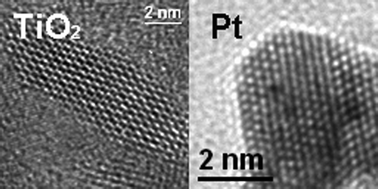Pt doping triggers growth of TiO2nanorods: nanocomposite synthesis and gas-sensing properties†
Abstract
TiO2

* Corresponding authors
a
Consiglio Nazionale delle Ricerche–Istituto per la Microeletronica ed I Microsistemi (CNR-IMM), via Monteroni c/o Campus Universitario, Lecce, Italy
E-mail:
mauro.epifani@le.imm.cnr.it
b EME/XaRMAE/IN2UB, Departament d'Electrònica, Universitat de Barcelona, C.\Martí i Franquès 1, E-08028 Barcelona, Spain
c Institut de Recerca en Energia de Catalunya (IREC), C/Josep Pla 2, B3, Ground Floor, E-08019 Barcelona, Spain
d Institut de Ciència de Materials de Barcelona, ICMAB-CSIC, Campus de la UAB, 08193 Bellaterra, CAT, Spain
e Institució Catalana de Recerca i Estudis Avançats (ICREA), Passeig Lluís Companys, 23, 08010 Barcelona, CAT, Spain
f CNR-IDASC, SENSOR Lab, Department of Chemistry and Physics, Brescia University, Via Valotti 9, Brescia, Italy
TiO2

 Please wait while we load your content...
Something went wrong. Try again?
Please wait while we load your content...
Something went wrong. Try again?
M. Epifani, T. Andreu, R. Zamani, J. Arbiol, E. Comini, P. Siciliano, G. Faglia and J. R. Morante, CrystEngComm, 2012, 14, 3882 DOI: 10.1039/C2CE06690D
To request permission to reproduce material from this article, please go to the Copyright Clearance Center request page.
If you are an author contributing to an RSC publication, you do not need to request permission provided correct acknowledgement is given.
If you are the author of this article, you do not need to request permission to reproduce figures and diagrams provided correct acknowledgement is given. If you want to reproduce the whole article in a third-party publication (excluding your thesis/dissertation for which permission is not required) please go to the Copyright Clearance Center request page.
Read more about how to correctly acknowledge RSC content.
 Fetching data from CrossRef.
Fetching data from CrossRef.
This may take some time to load.
Loading related content
